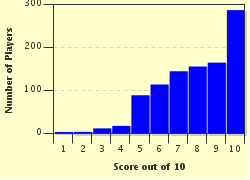Quiz Answer Key and Fun Facts
1. The literary mode of magical realism is primarily associated with Latin American writers writing in Spanish, although it is not their exclusive domain. Which of these is NOT considered a feature of this kind of writing?
2. The book "One Hundred Years of Solitude" (published in Spanish in 1967 as "Cien años de soledad") is often cited as a leading example of magical realism. Which Colombian author produced it?
3. The term 'magical realism' was first used in reference to the 1935 work "Historia universal de la infamia" ("A Universal History of Infamy") from an Argentine author who was later to share the inaugural Prix International with Samuel Beckett in 1961. Who was this seminal writer, who became blind in his mid-thirties?
4. The Chilean author Isabel Allende has included magical realism in some of her works, including her first novel, which told the family history of the Trueba family over a period of four generations. Which of these is the English title of her debut novel?
5. Laura Esquivel's first novel, "Like Water for Chocolate" (titled in Spanish "Como agua para chocolate" when published in 1989) focuses on the links between the natural and the supernatural that can be found in which room of the house?
6. The Nobel Prize-winning Guatemalan author Miguel Ángel Asturias Rosales published "Hombres de maíz" ("Men of Maize") in 1949. The title comes from the "Popol Vuh" ("Book of the People"), a sacred text from the Guatemalan highlands that predates Spanish colonization. Which of these indigenous people compiled this set of stories describing creation, a flood, epic tales and genealogies?
7. "The Kingdom of This World" (published in Spanish as "El reino de este mundo" in 1949) is a novella about Haitian life at the end of the 18th century and at the start of the 19th century, the time of the revolution which established the Haitian Republic. What is the nationality by which its author, Alejo Carpentier, identifies himself? (Remember, this is a quiz about Latin American literature.)
8. José Donoso Yáñez (1924-1996) was a Chilean author considered to be a leader in the development of magical realism. Which of these, considered by many to be his most significant work, makes use of the Chiloe Island myth of the monstrous Imbunche?
9. Which of these is the English title of a novel by Gabriel García Márquez which was made into a 2007 film starring Benjamin Bratt as Dr Juvenal Urbino, Giovanna Mezzogiorno as Fermina Urbino, and Javier Bardem as Florentino Ariza?
10. Juan Rulfo was a leading Mexican exponent of magical realism. Which of these (disappointingly for me) is the English translation of his collection of stories, "El llano en llamas"?
Source: Author
looney_tunes
This quiz was reviewed by FunTrivia editor
agony before going online.
Any errors found in FunTrivia content are routinely corrected through our feedback system.


